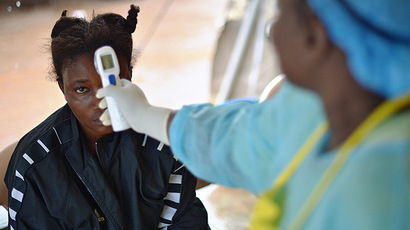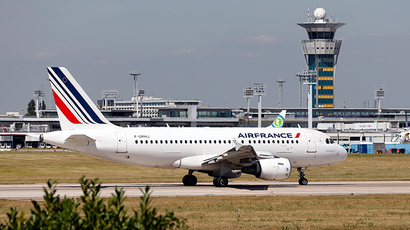75% chance Ebola will reach France by end October, 50% for UK – scientists

Scientists estimate there’s a 75 percent chance the Ebola virus could spread to France and a 50 percent chance it could reach UK by the end of October. The latest research analyzes the pattern of infection and airline traffic.
The consensus among health officials is now that the deadly virus is no longer just an African problem, and key to this assessment are the European Union’s free movement policy and the deceptive incubation period, allowing the person to spread the infection unaware.
France has the worst statistics out of all the European countries because the worst-hit countries in Africa are French-speaking, including Guinea, Sierra Leone and Liberia, according to the study ‘Assessing the International Spreading Risk Associated with the 2014 West African Ebola Outbreak’.
"If this thing continues to rage on in West Africa and indeed gets worse, as some people have predicted, then it's only a matter of time before one of these cases ends up on a plane to Europe,” expert in viruses from Britain's Lancaster University, Derek Gatherer, said.
The next country on the list after France and the UK is Belgium, with a 40 percent chance of infection. Meanwhile, Spain and Switzerland face smaller risks of the virus breaching its borders with 14 percent.
One of the key elements in analyzing the spread of the disease is air traffic, the leader behind the research, Alex Vespignani, from Northeastern University in Boston told Reuters.
"Air traffic is the driver," Vespignani said. "But there are also differences in connections with the affected countries (Guinea, Liberia and Sierra Leone), as well as different numbers of cases in these three countries - so depending on that, the probability numbers change."
While Vespignani admits the model is inconclusive, and could widen to include others, one thing is certain: the probability of contracting the virus is growing for everyone, “it’s just a matter of who gets lucky and who gets unlucky.”
Despite approaching the disease with extreme caution, the World Health Organization (WHO) placed no restrictions on flights to the worst-affected countries. And while British Airways and Emirates are no longer flying there, Air France has only suspended flights to Sierra Leone – not Liberia, Guinea or Nigeria (though air crews were recently offered the option to refuse flying to those destinations).
But the strategy for combatting the virus isn’t only dependent on air traffic regulations. The most dangerous contributor to the spread is the behavior of the virus. Its symptoms catch people unawares and normally follow a 21-day incubation period, during which there’s literally no visible sign the person has contracted Ebola.
This allows for circulation of sick passengers and is presumably how Liberian Thomas Eric Duncan was allowed to enter the US and remain there for several days with no knowledge of his condition.

This is further complicated by the EU’s free movement system – one can literally infect anyone they come into contact with in the space of a few days if they were to drive or fly from one country to another.
Airport screenings aren’t effective 100 percent of the time, due
to patients using fever-reducing drugs or simply lying to get on
the plane, as well as airport staff lacking competence in the
field.
READ MORE: Lies & ibuprofen: Airport Ebola checks rely on ‘honor system’, easily bypassed
The only mitigating factor here is that the disease is at its most contagious when the associated symptoms of profuse vomiting and diarrhea begin to manifest themselves, which occurs when the disease reaches terminal stage. By then, the patient is quickly isolated from the public.
But the prospects aren’t as grim when considering that the EU is mostly comprised of very well-developed countries. The ability to have a coordinated approach to the problem greatly lowers the risk and is “considered to be sufficient to interrupt any possible local transmission of the disease early," according to the latest assessment from the European Centers of Disease Prevention and Control.
This can be witnessed in Nigeria, which, despite its worst-hit neighbors in West Africa, still managed to stem the flow of infection to only 20 cases and eight deaths. The country is already on its way to being declared Ebola-free in a matter of weeks.
"Even if we have a worst-case scenario where someone doesn't present for medical treatment, or… it's not correctly identified as Ebola, and we get secondary transmission, it's not likely to be a very long secondary transmission chain," Gatherer says.
This is further helped by Europe’s “very sanitized, sterile lives” and the fact that it’s a much less crowded environment than the poverty-stricken settlements where infection is generally rife.
The new study comes as an Ebola-infected US citizen struggles for survival in a Texas hospital.
READ MORE: Texas Ebola patient fighting for life, new US drug ‘all gone’
The virus has so far taken the lives of over 3,400 people since March and has been declared the worst Ebola epidemic in history.














